Figure 1.
IL-17 induces inflammatory mediators to promote tumor progression. (A) IL-17 stimulates the production of myeloid-mobilizing cytokines (e.g., G-CSF) to expand myeloid cells, predominantly neutrophils or granulocytic MDSCs. These expanded myeloid cells are subsequently recruited to the tumor tissue by IL-17–induced chemokines (e.g., CXCL1 and CXCL5). The recruited myeloid cells can promote tumor progression by augmenting angiogenesis and suppressing antitumor immunity. In addition, IL-17–induced protumoral cytokines such as IL-6 function in a paracrine manner to enhance tumor growth and survival. (B) IL-17 induces the production of inflammatory mediators by activating transcription (e.g., NF-κB) and posttranscriptional regulation of gene expression. While Act1 is the adaptor protein for IL-17R, it also functions as a crucial RNA-binding protein that directs the formation of compartmentally distinct RNA–protein complexes to regulate the fate of otherwise unstable mRNAs. As part of the feedforward, self-reinforcing mechanism, Arid5a is induced by IL-17 to suppress the nuclease Regnase-1. Additionally, Regnase-1 is phosphorylated by TBK1/IKKi and thereby removed from the polysomes in an Act1-dependent manner. AA represents the poly A tail; P indicates a phosphorylation event. Reprinted with permission, Cleveland Clinic Center for Medical Art & Photography © 2019. All rights reserved.

